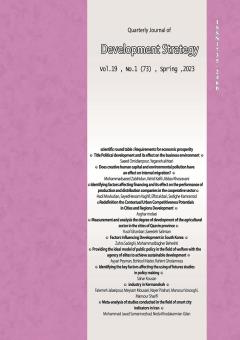Redefinition the Contextual Urban Competitiveness Potentials in Cities and Regions Development
Subject Areas :
1 - Assistant Professor of Urban Planning, Tabriz Islamic Art University, Tabriz, Iran
Keywords: Keywords: Urban Competitiveness, urban branding, identical contexts, economical sustainability, Development.,
Abstract :
Asghar molaei Abstract Contexts as valuable domestic elements and factors can have a high role in redefinition urban competitiveness. Studying in identical contexts, especially in the natural, cultural, social, and economic dimensions, will advance the sustainable competitive advantage, can be create the desirable economy future. The purpose of this research is to definition the role of identical contexts in urban competition and how to create competitive advantage in the context of an analytical and documentary research with an underlying strategy. Contextual competitive advantages can be defined in the natural, geographical, historical, physical, cultural, social, economic, and scientific and sports contexts. Contexts are a set of intrinsic and inseparable elements of phenomena, the emergence of their identity. The contexts of cities and regions are a constructive dimension of spatial, temporal, cultural, social, and other existing components. These areas represent the dynamic identity of cities and regions over time and space and are characterized by their differentiation. Identifying and focusing and emphasizing the value of identity of cities and regions in terms of capability and sustainability can help to improve their compatibility. In other words, the field of growth, progress and competitiveness of the power of cities and regions. The most important strategies presented are: development of religious tourism infrastructure; branding and development of historical, cultural, social, sporting, natural and environmental tourism infrastructure.
منابع
- بحرینی، سید حسین (1388)، تحلیل مبانی نظری طراحی شهری معاصر اواخر قرون 19 تا دهه هفتم قرن 20 میلادی، جلد اول، تهران: انتشارات دانشگاه تهران، چاپ اول.
- بهزادفر، مصطفی(1384)، «طراحی شهری در زمینه ¬بررسی موردی شهر بم»، فصلنامه آبادی، مرکز مطالعاتی و تحقیقاتی معماری و شهرسازی، وزارت مسکن و شهرسازی، 48.
- بهزادفر، مصطفی (1390)، هویت شهر نگاهی به هویت شهر تهران، تهران: نشر شهر، چاپ سوم.
- بيکن، ادموند(1376)، طراحي شهرها، ترجمه فرزانه طاهري، تهران: انتشارات مرکز مطالعاتی و تحقیقاتی معماری و شهرسازی ایران، چاپ اول.
- تولایی، نوین (1380)، «زمینه¬گرایی در شهرسازی»، فصلنامه هنرهای زیبا، 10، 43-34.
- تولایی، نوین (1386)، شکل شهر منسجم، تهران: انتشارات امیرکبیر، چاپ اول.
- دینی، کیت (1392)، برندینگ شهری یادسازی شهری، ترجمه محمدرضا رستمی، تهران: انتشارات سازمان زیباسازی شهرداری تهران، چاپ اول.
- رابرتز، ماریون؛ گرید، کلارا (1390)، رویکردی به¬سوی طراحی¬شهری (روشها و فنون طراحی-شهری)، ترجمه دکتر راضیه رضازاده و دکتر مطصفی عباسزادگان، تهران: انتشارات دانشگاه علم¬وصنعت ایران، چاپ اول.
- گروتر، یورگ (1375)، زیباشناختی در معماری، ترجمه جهانشاه پاکزاد و عبدالرضا همایون، تهران: انتشارات دانشگاه شهید بهشتی، چاپ اول.
- گلکار، کوروش(1387)، «محیط بصری شهر سیر تحول از رویکرد تزیینی تا رویکرد پایدار»، علوم محیطی، 5(4)، 114-95.
- فلامکی، محمد منصور (1396)، شهر ایرانی در سنجش جهانی، تهران: انجمن علمی فضای معماری نو ایران، موسسه علمی و فرهنگی فضا، چاپ اول.
- فلامکی، محمدمنصور (1384)، معماری بومی، فضایی ناشناخته، تهران: نشر فضا، چاپ اول.
- فلامکی، محمدمنصور (1389)، اندیشه معماران معاصر ایران، جلد اول، اندیشه معماران معاصر ایران: تعریف معماری و ضرورت نظریه¬پردازی¬های بومی، مصاحبه با دکتر فلامکی، گردآورنده اسماعیل آزادی، تهران: انجمن مفاخر معماری ایران، نشر فرهنگ صبا، چاپ اول.
- ماجدی، حمید؛ زرآبادی، زهراسادات¬سعیده (1389)، «شهر نشان¬دار به¬مثابه شهر زمینه¬گرا»، فصلنامه علمی پژوهشی تحقیقات فرهنگی، 3(3)، 1-22.
- نصیری، بهروز ؛ صمصامشریعت، سیدجمالالدین ؛ مهدنژاد، حافظ (1396)، رقابت¬پذیری شهری، تهران: انتشارات اراد کتاب، چاپ اول.
- Porter, Michael E. (2000), Location, Competition, and Economic Development: Local Clusters in a Global Economy. Economic Development Quarterly, 14 (1):15-34.
- Schwab, Klaus (2013), the Global Competitiveness Report 2013, Geneva: World Economic Forum.
- Schwab, Klaus. & Porter, Michael. E. (2008): The Global Competitiveness Report 2008 2009, Geneva: World Economic Forum.
- Anholt, S. (2004), Editor’s Foreword to the First issue Place Branding and Public Policy, 1(1).
- Anholt, S. (2007), Competitive Identity the New Brand Management for Nations, Cities and Regions. Palgrave Macmillan, Hampshire, Palgrave Macmilan Houndmills, Basingstoke, Hampshire RG21 6XS and 175 Fifth Avenue, New York, N.Y. 10010
- Dupeyras, A. and N. MacCallum (2013), Indicators for Measuring Competitiveness in Tourism: A Guidance, Document, OECD Tourism Papers, 2013/02, OECD, Publishing, http://dx.doi.org/10.1787/5k47t9q2t923-en
- Hassan Fathy (2007), Revisited, Postwar Discourses on Science, Development, and Vernacular, PANAYIOTA I. PYLA, University of Illinois at Urbana-Champaign, Architecture, Journal of Architectural Education, pp. 28–39 ª 2007 ACSA
- Hassan Fathy (1973), Architecture for the Poor: An Experiment in Rural Egypt. Chicago.
- -Trancik ,Roger(1986), Finding lost space: The Theories Of Spatial Urban Design, Van Nostrand, new York.
- Hsieh, Hsiu-Fang & Sarah E.Shanon (2005), Three Approaches to Qualitative Content Analysis, Qualitative Health Research, 1275-1288
- http://www.venezia.net
- https://www.toureiffel.paris
- https://www.marokko-info.nl
- http://www.golestanpalace.ir
- http://www.silkroadff.com
- https://www.mahallat.ir
- http://www.who.int
- https://ghalishooyan.ir
- https://amfm.ir
- https://www.mehrnews.com
- https://www.fcbarcelona.com
- http://www.nba.com
- https://www.bikecitizens.net
- http://www.iasp2014doha.com
- https://www.wisc.edu/about
- https://www.hel.fi
- https://ystp.ac.ir
- https://futurism.com
- http://www.toyota-global.com
- https://www.unog.ch

